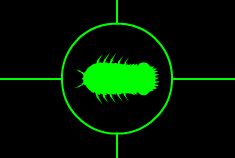
Giant Isopod
Other Names: None
Scientific Name: Bathynomus giganteus
Size Range: About 12 - 16 inches
Habitat: World wide
Depth Range: Over 2,000 feet
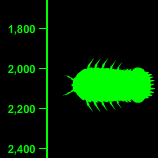
Giant Isopod
(Bathynomus giganteus)
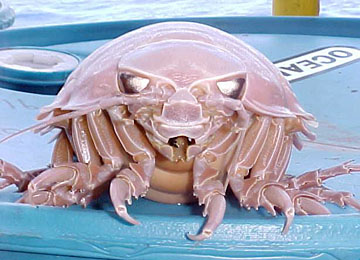
Giant isopod specimen - front view
(© Friend of User:Borgx / CC BY-SA 3.0)
Looking like it just crawled out of a bad science fiction movie, the giant isopod is without a doubt one of the strangest creatures found in the deep sea. Known scientifically as Bathynomus giganteus, it is one of about nine members of the genus Bathynomus. It is also the largest known members of the isopod family, a group of crustaceans closely related to shrimps and crabs. The giant isopod is also related to the small pillbugs that you can find in the garden. In fact, this insect-like creature is sometimes referred to as the giant pillbug. Giant isopods are not usually fished commercially, although some can be found in the occasional oceanside restaurant in northern Taiwan, where they are boiled and served with rice.
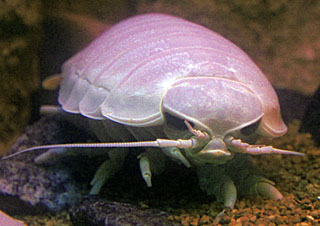
Giant isopod specimen at the
Virginia Aquarium and Marine Science Center
(Image © Sea and Sky)
The enormous size of the giant isopod is a result of a phenomenon known as deep sea gigantism. This is the tendency of deep sea crustaceans and other animals to grow to a much larger size than similar species in shallower waters. Other examples of this would be the giant squid and the giant tube worm. The giant squid grows to a length of up to 60 feet in the deep sea. In comparison, its shallow water cousins only grow to about two feet in length. The reason for these size differences remains a mystery, although some researchers believe it may be an adaptation to help the animal deal with the enormous pressures.
The giant isopod can grow to a length of over 16 inches, which makes it one of the largest members of the crustacean family. Like its terrestrial cousin, the pillbug, the giant isopod's body is protected by a hard shell that is divided into segments. This allows it to be strong and flexible at the same time. When threatened, this animal can roll itself into a ball to protect its vulnerable underside. And just like its land-based counterpart, the isopod has compound eyes, with over 4,000 individual facets. This gives the animal a large field of view, and makes it extremely sensitive to fast movements. Because light is extremely faint in the deep sea, the giant isopod has developed large antennae to help it feel its way around as it crawls along the ocean floor.
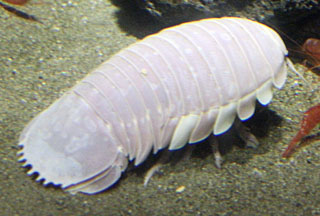
A giant isopod at the Tokyo Sea Life Park, Japan
(© Laika ac from USA / CC BY-SA 2.0)
The giant isopod is a carnivorous crustacean that spends its time scavenging the deep sea floor. Food is extremely scarce at these great depths, so the isopod has adapted to eat what ever happens to fall from above. This includes the bodies of dead whales, fish, and squid. It is believed that the isopod will also feed on some slow-moving animals such as sea cucumbers and sponges. The giant isopod has a complex mouth that with many components that work together to pierce, shred, and disembowel their prey. The isopod can go for long periods of time without eating and has been known to survive over eight weeks without food in when kept in captivity.
Giant isopods reproduce by laying eggs. These eggs are thought to be the largest of all the marine invertebrates. The females develop a pouch known as a marsupium, where the eggs are stored until the young are ready to emerge. When this happens, the young isopods escape from the marsupium as fully formed miniatures of the adults. At this stage, they are known as manca and are nearly fully developed. Bypassing the larval stage greatly enhances the young isopod's chances of survival.
Giant isopods are found in most oceans of the world. Their habitat ranges in depth from the dimly lit sublittoral zone at 550 ft (170 m) to the pitch darkness of the bathypelagic zone at 7,020 ft (2,140 m). They prefer mud or clay ocean bottom areas where they prefer to live solitary lives.
Deep Sea
Creature Database
'



